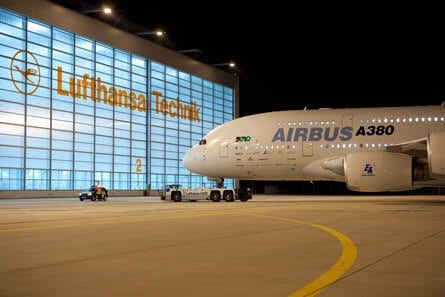Aviation
Lufthansa Technik is working on the first Airbus A380 passenger to cargo conversion

- First agreement for technical and engineering support on an Airbus A380
- Enquiries from more than 40 airlines
- More than 15 projects already in realization
Lufthansa Technik’s new technical and engineering services for temporary operational changes from passenger to cargo aircraft have met with great interest in the aviation market. So far, the cabin modification experts of the company have received enquiries from more than 40 airlines. More than 15 projects for different aircraft types are already in the implementation phase. A special highlight is the support of the operational change of a first Airbus A380 of an undisclosed customer with which Lufthansa Technik has now been awarded.
First Lufthansa Boeing 787-9 to be named “Berlin”
“Over the past days, we have received strong interest from different airlines regarding our passenger to freighter service capabilities,” explained Henning Jochmann, Senior Director Aircraft Modification Base Maintenance at Lufthansa Technik. “As the workscope comprises much more than just taking out seats, you need engineering experts who know exactly what the challenges are and how to document the technical solutions so correctly that the aviation authorities agree. The current exemption and our solution for it can be transferred to our Supplemental Type Certificate (STC) at a later point of time without major adjustments. This means that anyone who opts for Lufthansa Technik’s exceptional solution now can easily switch to the permanent STC solution later.
“Lufthansa Technik to convert Airbus A400M and A321neoLR into patient transport units
Normally, an aircraft that has been granted an approval for passenger transport cannot simply be loaded with cargo in the cabin, as the approval criteria for passenger cabins and cargo compartments are completely different.
For example, cargo has a different floor load, i.e. the structural load capacity of a passenger aircraft is lower than that of a cargo aircraft. While for passenger transport rescue routes must be kept clear and the oxygen supply must be ensured for each individual, special fire protection measures must be taken on board a freighter. All these criteria, and some more, must be taken into account and incorporated into the technical documentation by suitably qualified engineers and approved.
Lufthansa Technik is currently working flat out to obtain STCs for all common aircraft types so that airlines all over the world can quickly convert their passenger aircraft into auxiliary freighters.

Aviation
Airbus Enhances A350 Cabin with 10-Abreast Seating

Airbus has announced a new partnership with Jiatai Aircraft Equipment, a Chinese aircraft seating manufacturer, to supply upgraded economy-class seats for the A350 widebody series.
This collaboration, unveiled at the 2024 Airshow China, focuses on developing a newly designed economy seat tailored for the A350‘s New Production Standard (NPS) cabin.
One of the key features of the NPS cabin is the ability to accommodate 17-inch wide economy seats, compared to the previous 16.5-inch wide seats that airlines were limited to in the A350’s earlier configurations.
British Airways Unveils Its Brand-New First Class Cabin for the Airbus A380
This change is made possible by the expanded space in the NPS cabin, which is 35 inches longer and 4 inches wider than the previous version. This extra space is achieved by slightly moving the cockpit wall forward and shifting the rear pressure bulkhead back by one frame.
The wider cabin allows airlines to add up to 30 extra economy seats without compromising comfort. For airlines opting for a 3-4-3 seating layout, the 17-inch wide seats are an excellent choice for a more comfortable passenger experience. However, some airlines, such as Iberia, may choose to retain a 9-abreast layout with wider seats for added comfort.
The NPS cabin also offers enhanced flexibility for airline operators. One major advantage is the ability to easily switch between a 9-abreast and 10-abreast seating configuration without requiring significant downtime for aircraft reconfiguration. Airlines can use the same seat rails, tracks, and IFE interfaces, making the transition smoother and quicker.
Etihad Airways Unveils 10 Exciting New Routes for 2025
In addition, the design of the floor attachments and air-conditioning systems has been optimized for 10-abreast seating, meaning airlines can upgrade their cabins without needing to make substantial modifications to the aircraft’s structure.
Though it’s still unclear when Jiatai’s economy-class seats will be officially added to the A350’s Buyer Furnished Equipment (BFE) catalogue, the collaboration marks a significant step toward enhancing the A350’s cabin offerings.
With this partnership, Airbus is providing more seating options for airlines, ensuring that they can meet diverse customer needs while improving overall operational efficiency.
-

 Aviation2 months ago
Aviation2 months agoMicrosoft Flight Simulator Raises $3 Million to Bring Back the An-225 Mriya
-

 Airlines2 months ago
Airlines2 months agoQatar Citizens Can Travel to the United States Without a Visa
-

 Aviation2 months ago
Aviation2 months agoQatar Airways bans these new Electronic Devices on plane
-

 Airlines2 months ago
Airlines2 months agoJapan Airlines Rolls Out Free Domestic Flights to International Passengers
-

 Travel2 months ago
Travel2 months agoQatar Airways Launches Four Additional Flights from Amsterdam
-

 Defence2 months ago
Defence2 months agoWhich Country Has the Largest Fleet of Fighter Aircraft?
-

 Airport2 months ago
Airport2 months agoWestern Sydney Airport Welcomes Its First Plane After 6 Years of construction
-

 Airlines4 days ago
Airlines4 days agoDAMAC Air: Dubai’s New Luxury Airline Offers Free Flights for Registration








